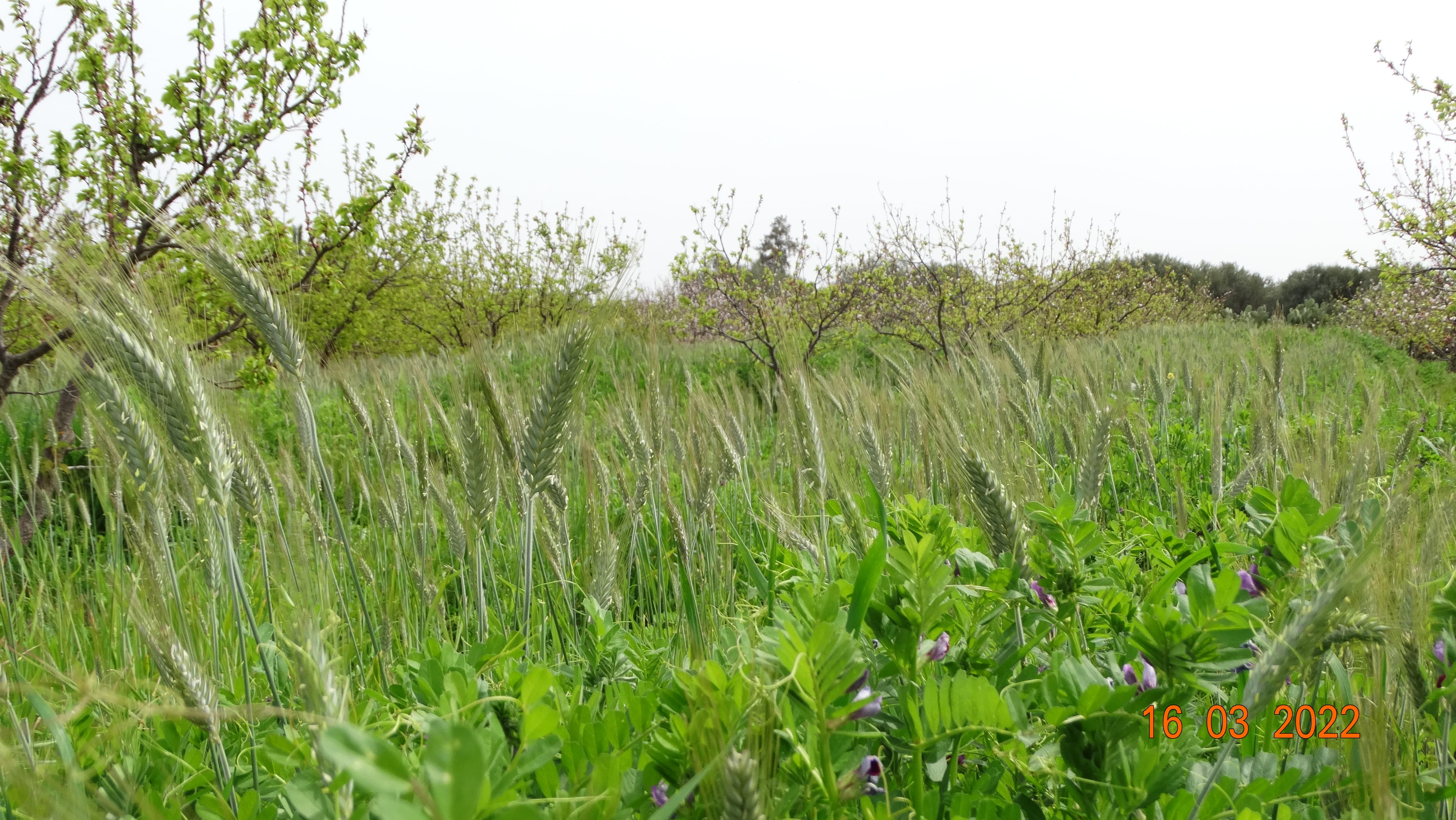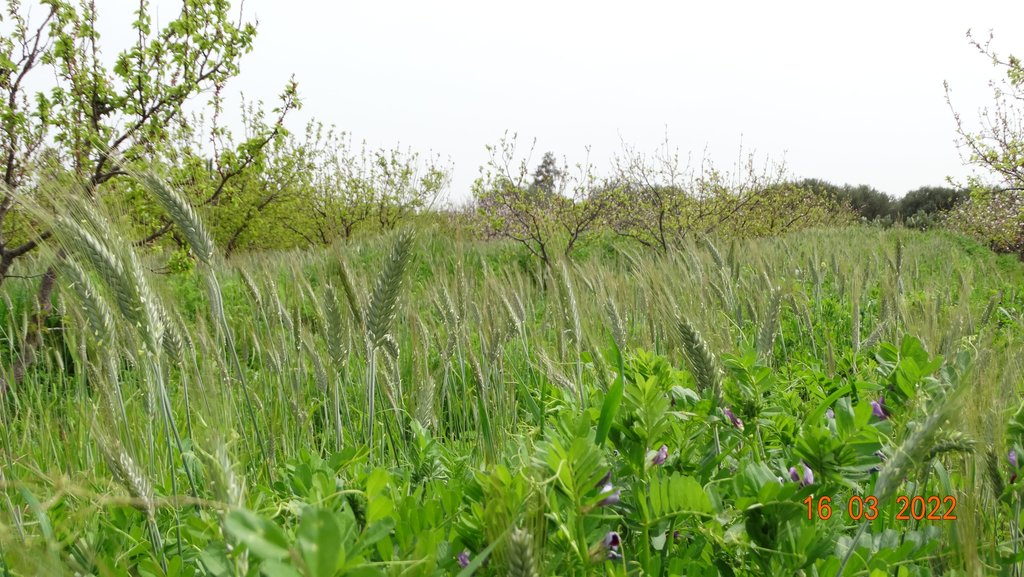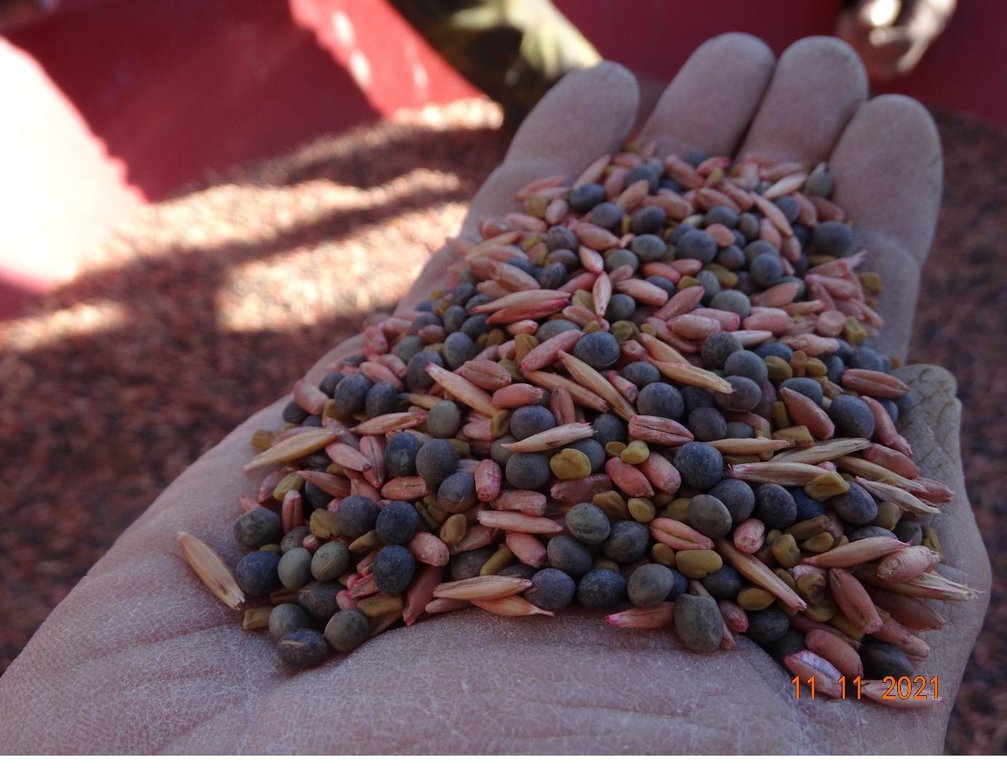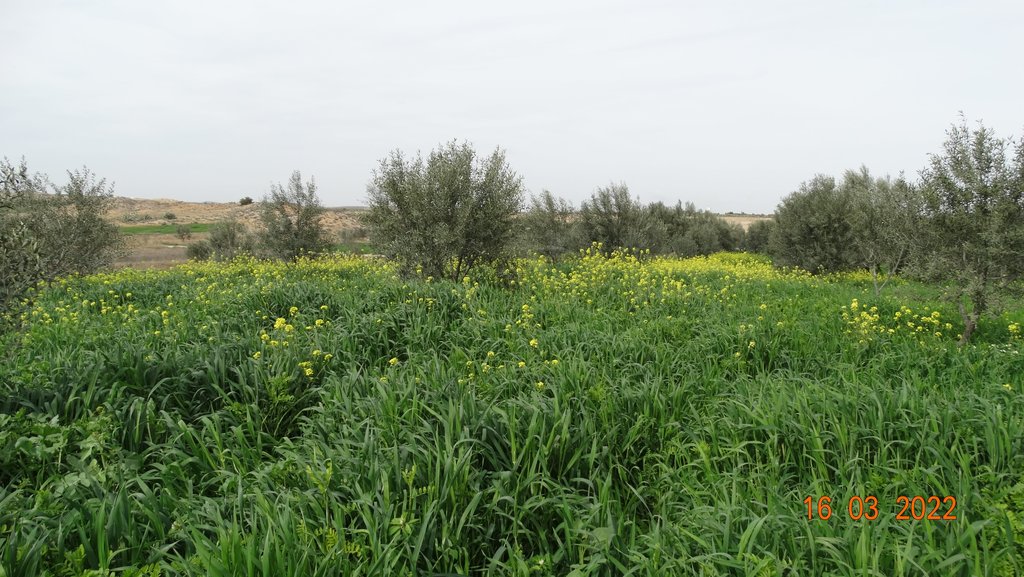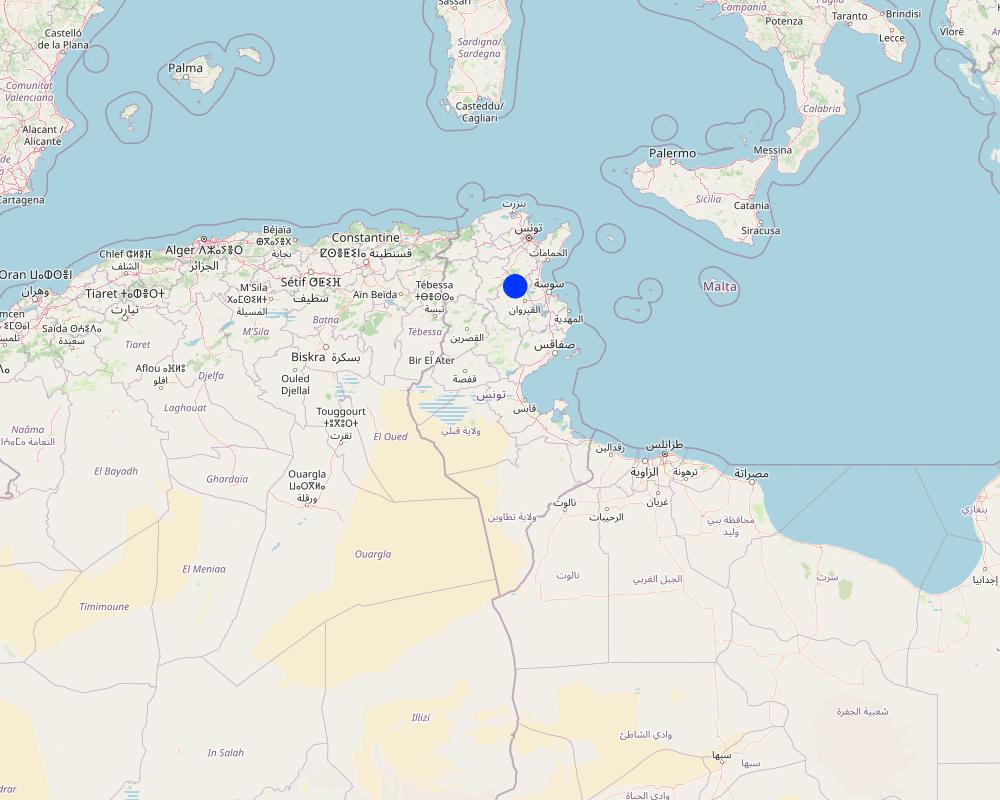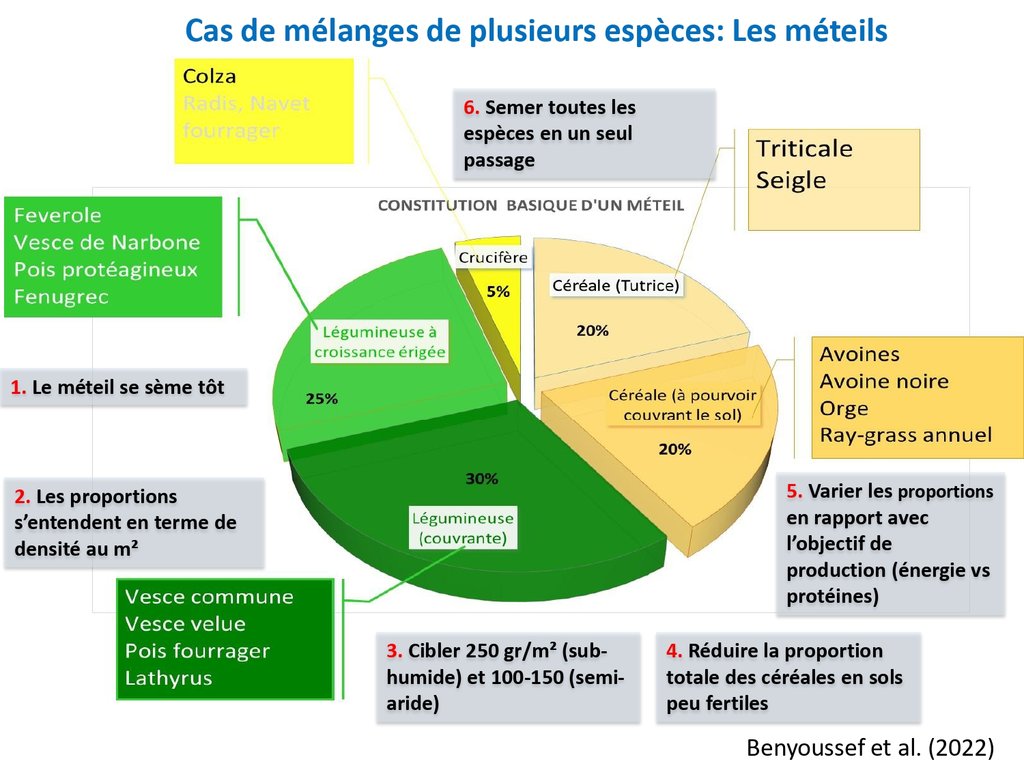Meslin: Mixed crops of cereals and legumes [Tunisia]
- Creation:
- Update:
- Compiler: Wafa Saidi
- Editors: Siagbé Golli, Faouzi Harrouchi, faouzi BATTI, Fatma Maaloul, Tabitha Nekesa, Ahmadou Gaye
- Reviewers: William Critchley, Rima Mekdaschi Studer
اللخلطات العلفية
technologies_6667 - Tunisia
View sections
Expand all Collapse all1. General information
1.2 Contact details of resource persons and institutions involved in the assessment and documentation of the Technology
Key resource person(s)
SLM specialist:
GRANIER May
Association Tunisienne d'Agriculture Environnementale
Tunisia
SLM specialist:
BEN ABDALLAH Mariem
Association Tunisienne d'Agriculture Environnementale
Tunisia
SLM specialist:
NASRI Bassem
Association Tunisienne d'Agriculture Environnementale
Tunisia
Name of project which facilitated the documentation/ evaluation of the Technology (if relevant)
Soil protection and rehabilitation for food security (ProSo(i)l)Name of the institution(s) which facilitated the documentation/ evaluation of the Technology (if relevant)
Association Tunisienne d'Agriculture Environnementale (ATAE) - TunisiaName of the institution(s) which facilitated the documentation/ evaluation of the Technology (if relevant)
Direction Générale de l’Amenagement et de Conservation des Terres Agricoles (DG/ACTA) - TunisiaName of the institution(s) which facilitated the documentation/ evaluation of the Technology (if relevant)
GIZ Tunisia (GIZ Tunisia) - Tunisia1.3 Conditions regarding the use of data documented through WOCAT
The compiler and key resource person(s) accept the conditions regarding the use of data documented through WOCAT:
Yes
1.4 Declaration on sustainability of the described Technology
Is the Technology described here problematic with regard to land degradation, so that it cannot be declared a sustainable land management technology?
No
1.5 Reference to Questionnaire(s) on SLM Approaches (documented using WOCAT)
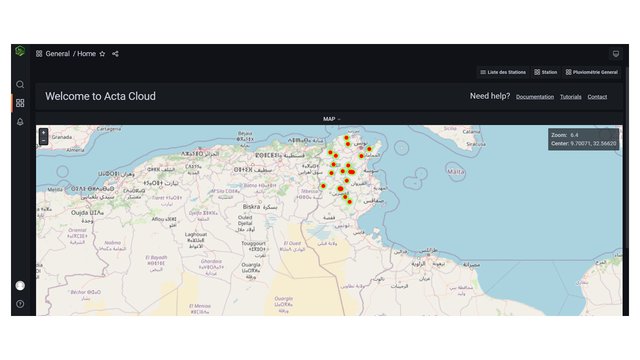
Territorial Natural Resource Management Observatory [Tunisia]
A territorial natural resources management observatory is a scientific, technical and institutional system set up in a given area to observe, monitor and improve knowledge.
- Compiler: Wafa Saidi
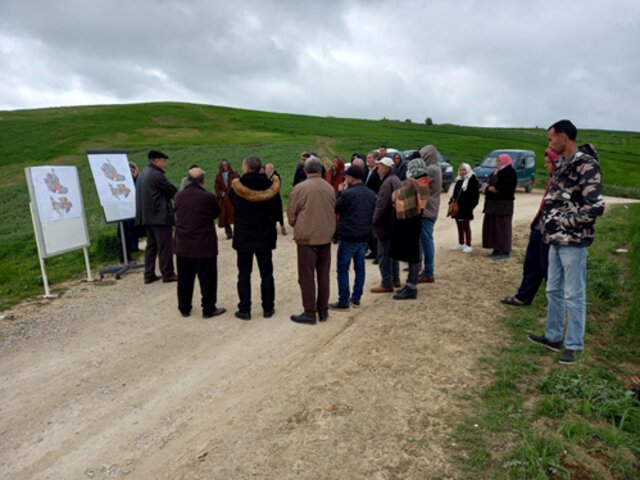
Integrated Territorial Planning and Development Project (PADIT) [Tunisia]
The PADIT approach comprises a cross-cutting participatory methodology to rural development, rallying various stakeholders around a project, within a location, to identify the main economic areas of the rural community concerned, and draw up a prioritized list of actions to strengthen and support development efforts in their location.
- Compiler: Wafa Saidi
2. Description of the SLM Technology
2.1 Short description of the Technology
Definition of the Technology:
Meslin consists of a planting mix of cereals and legumes, formulated for both livestock feed and soil rehabilitation purposes.
2.2 Detailed description of the Technology
Description:
Meslin is a practice of intercropping that has been introduced in various regions characterized by a minimum rainfall of 250 mm. It can be applied to a wide range of soil textures and even in high-altitude areas such as the mountainous regions of the north-west (e.g., the Kroumirie region) and parts of the central-west (e.g., the Mogod region).
Farmers, driven by the need for food and protein self-sufficiency for their livestock while minimizing inputs, are increasingly turning to meslin. Climate change has prompted them to diversify their food resources, making meslin a strategic solution for grazing systems and a crop cultivated for agronomic, nutritional, and economic benefits. Meslin provides high-quality hay and serves as beneficial ground cover to suppress weeds.
The composition of meslin varies widely, from mixtures with predominantly cereals to purely leguminous crops. It can be used in a variety of ways and on all types of farms (in open fields, alternating with other seasonal crops, as part of a medium-term crop rotation system or in a mature tree orchard).
Before sowing, ploughing is recommended, along with the application of 100 kg/ha of compound fertilizer. Sowing is recommended from September 30 to mid-December. Species are mixed and sown in a single pass at a depth of 2-3 cm and a spacing of 12-15 cm. The sowing rate is 130 kg/ha. This mixture requires no weeding or extra fertilizing, but requires effective water management during critical growth stages.
Meslin can be harvested at different stages depending on weather conditions and the farmer's objectives. To prepare green fodder for cattle, meslin is mowed in slices on a daily basis and pre-mowed half a day before distribution. For silage, mowing must take place at the stage of the first green pods of leguminous plants, followed by silage making after a short pre-tanning period.
Farmers who have embraced meslin have expressed satisfaction, reporting higher economic gains compared to conventional forage like oats.
2.3 Photos of the Technology
2.5 Country/ region/ locations where the Technology has been applied and which are covered by this assessment
Country:
Tunisia
Region/ State/ Province:
Sbikha, Kairouan
Specify the spread of the Technology:
- evenly spread over an area
If precise area is not known, indicate approximate area covered:
- 0.1-1 km2
Is/are the technology site(s) located in a permanently protected area?
No
Map
×2.6 Date of implementation
Indicate year of implementation:
2021
If precise year is not known, indicate approximate date:
- less than 10 years ago (recently)
2.7 Introduction of the Technology
Specify how the Technology was introduced:
- during experiments/ research
Comments (type of project, etc.):
From 2003, as part of research projects
3. Classification of the SLM Technology
3.1 Main purpose(s) of the Technology
- improve production
- reduce, prevent, restore land degradation
- preserve/ improve biodiversity
- adapt to climate change/ extremes and its impacts
- create beneficial economic impact
3.2 Current land use type(s) where the Technology is applied
Land use mixed within the same land unit:
Yes
Specify mixed land use (crops/ grazing/ trees):
- Agro-silvopastoralism

Cropland
- Annual cropping
- Tree and shrub cropping
Annual cropping system:
Maize or similar rotation with hay/pasture
Tree and shrub cropping - Specify crops:
- olive
Is intercropping practiced?
Yes

Grazing land
Extensive grazing:
- Ranching
Intensive grazing/ fodder production:
- Improved pastures
Animal type:
- cattle - dairy
Is integrated crop-livestock management practiced?
Yes
Products and services:
- milk
Species:
cattle - dairy
3.3 Has land use changed due to the implementation of the Technology?
Has land use changed due to the implementation of the Technology?
- No (Continue with question 3.4)
3.4 Water supply
Water supply for the land on which the Technology is applied:
- mixed rainfed-irrigated
3.5 SLM group to which the Technology belongs
- rotational systems (crop rotation, fallows, shifting cultivation)
- integrated crop-livestock management
- integrated soil fertility management
3.6 SLM measures comprising the Technology

agronomic measures
- A1: Vegetation/ soil cover
- A2: Organic matter/ soil fertility
- A3: Soil surface treatment
A3: Differentiate tillage systems:
A 3.2: Reduced tillage (> 30% soil cover)

vegetative measures
- V4: Replacement or removal of alien/ invasive species

management measures
- M2: Change of management/ intensity level
Comments:
Meslin can be intercropped with other varieties of crops
3.7 Main types of land degradation addressed by the Technology

soil erosion by water
- Wt: loss of topsoil/ surface erosion

chemical soil deterioration
- Cn: fertility decline and reduced organic matter content (not caused by erosion)

physical soil deterioration
- Pk: slaking and crusting

biological degradation
- Bc: reduction of vegetation cover
- Bh: loss of habitats
- Bs: quality and species composition/ diversity decline
- Bl: loss of soil life
- Bp: increase of pests/ diseases, loss of predators

water degradation
- Hs: change in quantity of surface water
- Hg: change in groundwater/aquifer level
- Hw: reduction of the buffering capacity of wetland areas
3.8 Prevention, reduction, or restoration of land degradation
Specify the goal of the Technology with regard to land degradation:
- reduce land degradation
- restore/ rehabilitate severely degraded land
4. Technical specifications, implementation activities, inputs, and costs
4.1 Technical drawing of the Technology
Technical specifications (related to technical drawing):
A standard meslin consists of:
-a cereal with supporting capacity (triticale, rye)
-a second cereal with covering capacity (oats, barley, black oats, annual ryegrass)
-a robust legume with upright growth (broad bean, leguminous peas, fenugreek, Narbon vetch)
-a legume with spreading growth (common vetch, forage peas, hairy vetch, Lathyrus)
-and a cruciferous plant (rapeseed or other).
These proportions vary depending on the quality of the soil, rainfall, and the production objective (energy-rich or protein-rich hay)
Author:
Salah BENYOUSSEF et al
Date:
2022
4.2 General information regarding the calculation of inputs and costs
Specify how costs and inputs were calculated:
- per Technology area
Indicate size and area unit:
1 ha
other/ national currency (specify):
Tunisian dinars
If relevant, indicate exchange rate from USD to local currency (e.g. 1 USD = 79.9 Brazilian Real): 1 USD =:
3.1
Indicate average wage cost of hired labour per day:
20
4.3 Establishment activities
| Activity | Timing (season) | |
|---|---|---|
| 1. | Summary plowing | September 30 to mid-October |
| 2. | Seeding | September 30 to mid-December |
| 3. | Irrigation | From November onwards, if no rain, light irrigation once a week |
| 4. | Green mowing | From January to early March |
| 5. | Dry mowing | Mid-April |
4.4 Costs and inputs needed for establishment
If land user bore less than 100% of costs, indicate who covered the remaining costs:
Tunisian Environmental Agriculture Association (ATAE)
Comments:
Under the Prosol project, seed was provided free of charge in the first year of production, while in the second year, farmers paid 50% of the cost of the seed.
4.5 Maintenance/ recurrent activities
| Activity | Timing/ frequency | |
|---|---|---|
| 1. | Summary plowing | September 30 to mid-October |
| 2. | Seeding | September 30 to mid-December |
| 3. | 30 and 100 kg triple superphosphate or DAP | Early October |
| 4. | Irrigation | From November onwards, if no rain, light irrigation once a week |
| 5. | Green mowing | From January to early March |
| 6. | Dery mowing | Mid-April |
4.6 Costs and inputs needed for maintenance/ recurrent activities (per year)
If you are unable to break down the costs in the table above, give an estimation of the total costs of maintaining the Technology:
1595.0
If land user bore less than 100% of costs, indicate who covered the remaining costs:
Tunisian Environmental Agriculture Association (ATAE)
Comments:
Under the Prosol project, seed was provided free of charge in the first year of production, while in the second year, farmers paid 50% of the cost of the seed.
4.7 Most important factors affecting the costs
Describe the most determinate factors affecting the costs:
- Plowing and seeding
- Availability of seeds on the market
5. Natural and human environment
5.1 Climate
Annual rainfall
- < 250 mm
- 251-500 mm
- 501-750 mm
- 751-1,000 mm
- 1,001-1,500 mm
- 1,501-2,000 mm
- 2,001-3,000 mm
- 3,001-4,000 mm
- > 4,000 mm
Specify average annual rainfall (if known), in mm:
310.00
Specifications/ comments on rainfall:
The average annual rainfall calculated over a 34-year period is 310 mm, displaying significant inter-annual variability spanning from 113 mm to 525 mm.
A study of the seasonal distribution of rainfall shows that autumn is the wettest season, boasting an average of 124.5 mm. This rainfall accounts for 40% of the average annual contribution. Summer, however, stands out as the dry season, contributing only 9% of the average annual rainfall. This rainfall pattern is typical of central Tunisia.
Indicate the name of the reference meteorological station considered:
Sbikha Délégation
Agro-climatic zone
- semi-arid
The average air temperature recorded is around 19.8°C. In fact, the average annual maximum temperature is 26.2°C, while the average average minimum is 13.6°C.
5.2 Topography
Slopes on average:
- flat (0-2%)
- gentle (3-5%)
- moderate (6-10%)
- rolling (11-15%)
- hilly (16-30%)
- steep (31-60%)
- very steep (>60%)
Landforms:
- plateau/plains
- ridges
- mountain slopes
- hill slopes
- footslopes
- valley floors
Altitudinal zone:
- 0-100 m a.s.l.
- 101-500 m a.s.l.
- 501-1,000 m a.s.l.
- 1,001-1,500 m a.s.l.
- 1,501-2,000 m a.s.l.
- 2,001-2,500 m a.s.l.
- 2,501-3,000 m a.s.l.
- 3,001-4,000 m a.s.l.
- > 4,000 m a.s.l.
5.3 Soils
Soil depth on average:
- very shallow (0-20 cm)
- shallow (21-50 cm)
- moderately deep (51-80 cm)
- deep (81-120 cm)
- very deep (> 120 cm)
Soil texture (topsoil):
- medium (loamy, silty)
Soil texture (> 20 cm below surface):
- medium (loamy, silty)
Topsoil organic matter:
- medium (1-3%)
- low (<1%)
5.4 Water availability and quality
Ground water table:
> 50 m
Availability of surface water:
good
Water quality (untreated):
good drinking water
Water quality refers to:
both ground and surface water
Is water salinity a problem?
No
Is flooding of the area occurring?
No
5.5 Biodiversity
Species diversity:
- medium
Habitat diversity:
- medium
5.6 Characteristics of land users applying the Technology
Sedentary or nomadic:
- Sedentary
Market orientation of production system:
- mixed (subsistence/ commercial)
Off-farm income:
- less than 10% of all income
Relative level of wealth:
- average
Individuals or groups:
- individual/ household
Level of mechanization:
- manual work
- mechanized/ motorized
Gender:
- women
- men
Age of land users:
- youth
- middle-aged
- elderly
5.7 Average area of land used by land users applying the Technology
- < 0.5 ha
- 0.5-1 ha
- 1-2 ha
- 2-5 ha
- 5-15 ha
- 15-50 ha
- 50-100 ha
- 100-500 ha
- 500-1,000 ha
- 1,000-10,000 ha
- > 10,000 ha
Is this considered small-, medium- or large-scale (referring to local context)?
- medium-scale
5.8 Land ownership, land use rights, and water use rights
Land ownership:
- individual, not titled
Land use rights:
- individual
Water use rights:
- individual
Are land use rights based on a traditional legal system?
No
5.9 Access to services and infrastructure
health:
- poor
- moderate
- good
education:
- poor
- moderate
- good
technical assistance:
- poor
- moderate
- good
employment (e.g. off-farm):
- poor
- moderate
- good
markets:
- poor
- moderate
- good
energy:
- poor
- moderate
- good
roads and transport:
- poor
- moderate
- good
drinking water and sanitation:
- poor
- moderate
- good
financial services:
- poor
- moderate
- good
6. Impacts and concluding statements
6.1 On-site impacts the Technology has shown
Socio-economic impacts
Production
crop production
Comments/ specify:
The farmer used meslin intercropped with olive trees. Olive tree production increased by 50%.
crop quality
fodder production
Quantity before SLM:
250 bales of oats
Quantity after SLM:
310 bales with meslin
fodder quality
Comments/ specify:
Meslin is a source of protein for livestock.
animal production
Comments/ specify:
- An increase of around 5 liters per cow
- Improved milk quality.
risk of production failure
product diversity
Comments/ specify:
Intercropping is possible
production area
Comments/ specify:
The productive agricultural land is effectively utilized (double production: arboriculture and forage)
land management
Comments/ specify:
Minimize plowing
Water availability and quality
demand for irrigation water
Comments/ specify:
Irrigation once a week during the dry season
Income and costs
expenses on agricultural inputs
Comments/ specify:
A 2/3 reduction in the use of ammonium nitrate fertilizer
farm income
diversity of income sources
Comments/ specify:
Various products: olives, olive oil, milk, fodder and seeds
workload
Comments/ specify:
- Minimize agricultural inputs
- Minimize ploughing
Socio-cultural impacts
food security/ self-sufficiency
SLM/ land degradation knowledge
Ecological impacts
Water cycle/ runoff
water quantity
Comments/ specify:
Minimize evapotranspiration and improve infiltration
evaporation
Comments/ specify:
The intensity of the vegetation cover minimizes evaporation.
Soil
soil moisture
Comments/ specify:
Meslin improves soil moisture.
soil cover
soil loss
soil crusting/ sealing
soil compaction
nutrient cycling/ recharge
salinity
Comments/ specify:
Decreased electrical conductivity
soil organic matter/ below ground C
Comments/ specify:
Improved durum wheat production in crop rotation, and reduced use of chemical inputs
Biodiversity: vegetation, animals
Vegetation cover
biomass/ above ground C
invasive alien species
Comments/ specify:
Yellow nightshade does not exist on the plot.
animal diversity
Comments/ specify:
l'apparition des coccinelles
beneficial species
Comments/ specify:
Vesces
habitat diversity
pest/ disease control
Climate and disaster risk reduction
drought impacts
Comments/ specify:
Meslin is drought-resistant.
impacts of cyclones, rain storms
Comments/ specify:
The intensity of the vegetation cover minimizes the damage caused by torrential rains.
emission of carbon and greenhouse gases
Comments/ specify:
Nitrogen fixation by leguminous plants.
wind velocity
micro-climate
Specify assessment of on-site impacts (measurements):
Meslin has been tested in Tunisia since 2009, and the results from all plots have been documented by researchers from the National Agronomic Research Institute of Tunisia. In addition, a post-harvest survey was carried out among farmers to ascertain the results.
6.2 Off-site impacts the Technology has shown
groundwater/ river pollution
buffering/ filtering capacity
impact of greenhouse gases
Comments/ specify:
Meslin is a carbon sink.
6.3 Exposure and sensitivity of the Technology to gradual climate change and climate-related extremes/ disasters (as perceived by land users)
Gradual climate change
Gradual climate change
| Season | increase or decrease | How does the Technology cope with it? | |
|---|---|---|---|
| seasonal temperature | summer | increase | moderately |
| annual rainfall | decrease | moderately |
Climate-related extremes (disasters)
Meteorological disasters
| How does the Technology cope with it? | |
|---|---|
| local hailstorm | moderately |
6.4 Cost-benefit analysis
How do the benefits compare with the establishment costs (from land users’ perspective)?
Short-term returns:
very positive
Long-term returns:
very positive
How do the benefits compare with the maintenance/ recurrent costs (from land users' perspective)?
Short-term returns:
very positive
Long-term returns:
very positive
6.5 Adoption of the Technology
- 1-10%
If available, quantify (no. of households and/ or area covered):
45 ha
Of all those who have adopted the Technology, how many did so spontaneously, i.e. without receiving any material incentives/ payments?
- 11-50%
Comments:
Most adopters received subsidies from the PROSOL/GIZ project.
6.6 Adaptation
Has the Technology been modified recently to adapt to changing conditions?
Yes
other (specify):
Seed availability
Specify adaptation of the Technology (design, material/ species, etc.):
The composition of meslin has changed due to seed shortage and drought.
6.7 Strengths/ advantages/ opportunities of the Technology
| Strengths/ advantages/ opportunities in the land user’s view |
|---|
| Meslin has a positive impact on soil quality. |
| Meslin production costs are lower than the cost of conventional forage (oats). |
| Milk quality has changed. |
| Strengths/ advantages/ opportunities in the compiler’s or other key resource person’s view |
|---|
| Soil rehabilitation |
| Solving an economic problem (obtaining production in degraded terrain) |
| Good-quality forage (source of energy and protein for livestock) |
6.8 Weaknesses/ disadvantages/ risks of the Technology and ways of overcoming them
| Weaknesses/ disadvantages/ risks in the compiler’s or other key resource person’s view | How can they be overcome? |
|---|---|
| Lack of seeds | Use locally-adapted seeds |
| Adoption by farmers | Raising awareness among farmers |
7. References and links
7.1 Methods/ sources of information
- field visits, field surveys
A visit to the Sbikha zone in Kairouan
- interviews with land users
Two farmers were interviewed.
- interviews with SLM specialists/ experts
Three specialists were interviewed.
- compilation from reports and other existing documentation
When were the data compiled (in the field)?
05/03/2023
7.2 References to available publications
Title, author, year, ISBN:
Guide des bonnes pratiques agricoles, Association Tunisienne d'Agriculture Environnementale (ATAE), 2019
Available from where? Costs?
Tunisian Environmental Agriculture Association (ATAE)
Title, author, year, ISBN:
Rapport d'activités projet PROSOL/ATAE, Association Tunisienne d'Agriculture Environnementale (ATAE), 2022
Available from where? Costs?
Tunisian Environmental Agriculture Association (ATAE)
Title, author, year, ISBN:
Carte agricole de la Tunisie, Ministère de l’agriculture, 2005
Available from where? Costs?
Ministry of Agriculture, Directorate-General for the Development and Conservation of Agricultural Lands
Title, author, year, ISBN:
Factsheet "Successful fodder mixes", Association Tunisienne d'Agriculture Environnementale (ATAE)
Available from where? Costs?
Tunisian Environmental Agriculture Association (ATAE)
Title, author, year, ISBN:
Factsheet "Cover crops", Association Tunisienne d'Agriculture Environnementale (ATAE)
Available from where? Costs?
Tunisian Environmental Agriculture Association (ATAE)
Title, author, year, ISBN:
Factsheet "Combined cropping - six forage mixtures", Association Tunisienne d'Agriculture Environnementale (ATAE)
Available from where? Costs?
Tunisian Environmental Agriculture Association (ATAE)
7.3 Links to relevant online information
Title/ description:
Guide technique des mélanges fourragers à base de céréales à paille et de légumineuses, Agathe Legendre, Bertrand Bouffartigue, D. Deleau, Michel Deraedt, Elodie Desmoniere, et al., 2018
URL:
https://hal.inrae.fr/hal-02788708/document
Title/ description:
Harmonized World Soil Database, FAO, 2009
URL:
https://www.fao.org/soils-portal/data-hub/soil-maps-and-databases/harmonized-world-soil-database-v12/en/
Links and modules
Expand all Collapse allLinks

Territorial Natural Resource Management Observatory [Tunisia]
A territorial natural resources management observatory is a scientific, technical and institutional system set up in a given area to observe, monitor and improve knowledge.
- Compiler: Wafa Saidi

Integrated Territorial Planning and Development Project (PADIT) [Tunisia]
The PADIT approach comprises a cross-cutting participatory methodology to rural development, rallying various stakeholders around a project, within a location, to identify the main economic areas of the rural community concerned, and draw up a prioritized list of actions to strengthen and support development efforts in their location.
- Compiler: Wafa Saidi
Modules
No modules


